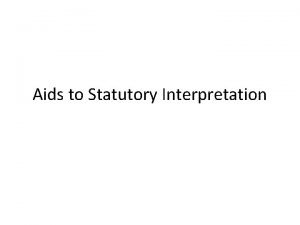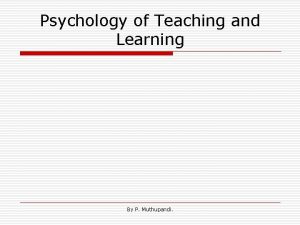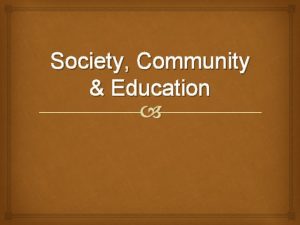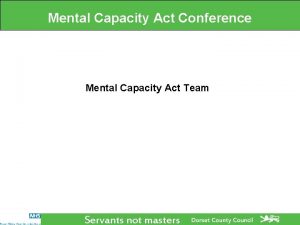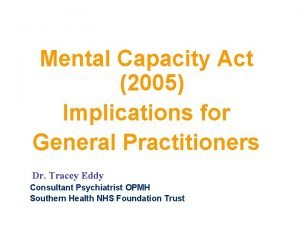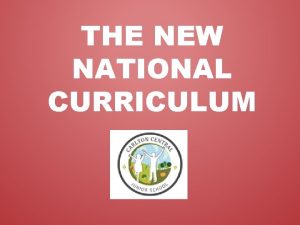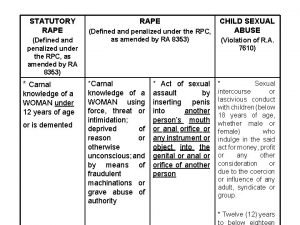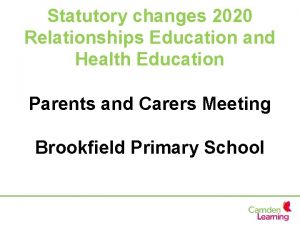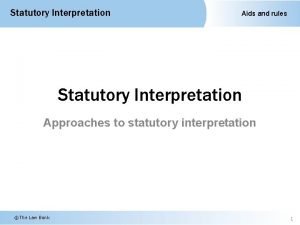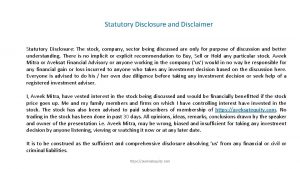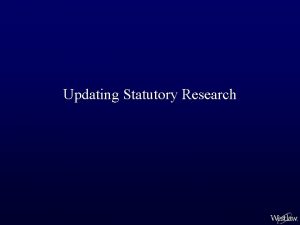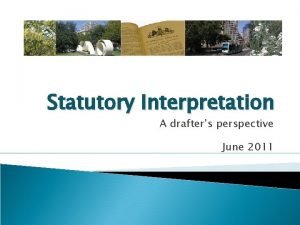Statutory Health and Relationship Education 20 21 Statutory













- Slides: 13

Statutory Health and Relationship Education 20 -21

Statutory Relationship, Sex and Health Education for Schools from Summer 2021 Prior to this guidance, the guidance hadn’t been updated since 2000. “To embrace the challenges of creating a happy and successful adult life, pupils need knowledge that will enable them to make informed decisions about their wellbeing, health and relationships and to build their selfefficacy” (Df. E, 2019). Effective Relationship, Sex and Health Education prepares our pupils for their future lives, whilst also enhancing their spiritual, moral, social and cultural development provision.

Significant Changes in the Guidance Much greater emphasis on how we need to prepare pupils for online and offline life and preparation for the future. LGBT should be integrated into the curriculum rather than stand-alone and be taught in an age appropriate manner. At Primary School, for instance, when looking at families, a range of families should be represented. “From the beginning, teachers should talk explicitly about the features of healthy friendships, family relationships and other relationships which young children are likely to encounter. Drawing attention to these in a range of contexts should enable pupils to form a strong early understanding of the features of relationships that are likely to lead to happiness and security. This will also help them to recognise any less positive relationships when they encounter them. ” (Df. E, 2019) In Primary, Relationships and Health education is statutory and Sex Education is advised at a level appropriate to the age of the children. The curriculum must reflect the needs of the local context and community

Df. E Guidance Relationship and Health Education Primary Relationships Education Primary Physical and Mental Health Families and people who care for me Wellbeing Mental wellbeing Caring friendships Internet safety and harms Respectful relationships Physical health and fitness Online relationships Healthy eating Being safe Drugs, alcohol and tobacco Health and prevention Basic first aid Changing adolescent body

Chagford Relationship, Heath and Sex Education This will be taught as part of regular Physical, Social and Health Education lessons. The curriculum is devised by Coram, a charity working on keeping children safe. It covers the breadth of PSHE from relationships and sex education (RSE) and health, to economic wellbeing and careers, setting out suggested content for each year group. Our curriculum goes further than the government curriculum to include topics like citizenship and financial education. The curriculum is a spiral curriculum with children returning to key themes (e. g. online safety) and studying that theme a in a little more depth each year as is appropriate for their age. PSHE is taught regularly either once a week or in a block of lessons if this is appropriate or as a particular issue arises. The lessons are taught by the class teacher. There is also provision for children with special educational needs and extra nurture are run to support those children who need this.

Chagford C of E Primary School ‘SCARF Curriculum’ SCARF stands for Safety, Caring, Achievement, Resilience, Friendship SCARF is a curriculum for PHSCE including Relationships and Sex Education which is produced by Coram – a well respected charity working to improve the lives and life-chances of the UK’s children and young people. Coram's mission is to develop, deliver and promote best practice in the support of vulnerable children and young people. Our vision is that every child has the best possible chance to lead a fulfilling life. We champion what matters most for children, creating better chances, and a brighter, happier future.

What do children learn in SCARF lessons? For each year group, there are six suggested themed units which provide a complete PSHE and wellbeing curriculum. They are: Me and My Relationships Valuing Difference Keeping Myself Safe Rights and Responsibilities Being My Best Growing and Changing

What do children learn in SCARF lessons? SCARF RSE-specific lessons are designed to cover key skills, attitudes and values children need to explore in order to develop healthy relationships with their peers. Children also learn how to keep themselves safe and to ask for help when they need it. 4 -5 year-olds: being the same and different, our special people, different families, different homes, our feelings, being unique and special, being kind, caring and friendly, keeping safe, keeping healthy, resilience, life stages and growing from young to old. 5 -6 year olds: explores themes around families and their special people, the importance of respecting others including those that are different from us, recognising that genitals are private and their correct names; develops understanding of the difference between surprises and secrets (good or bad secrets) and when not to keep bad adult secrets; helps develop judgement of what kind of physical contact is acceptable or unacceptable and how to respond to this (including who to tell and how to tell them). 6 -7 year-olds: looks at the process of growing from young to old and how people’s needs change; explores the opportunities and responsibilities that increasing independence can bring, recognising that they share a responsibility for keeping themselves and others safe.

What do children learn in SCARF lessons? 6 -7 year-olds: looks at the process of growing from young to old and how people’s needs change; explores the opportunities and responsibilities that increasing independence can bring, recognising that they share a responsibility for keeping themselves and others safe. 7 -8 year-olds: introduces themes about change, including menstruation and bereavement, healthy and unhealthy relationships (friendships), how images in the media do not always reflect reality and the impact of this on people’s thoughts and feelings; the nature and consequences of discrimination; the importance of protecting personal information online; understanding risk and building resilience; making informed choices; resisting pressure and recognising when and how to ask for help. 8 -9 year-olds: builds on themes covered in previous years, looking more closely at body changes as they approach and move through puberty including: menstruation and human reproduction; conflicting emotions; what positively and negatively affects their physical, mental and emotional health; understanding good and not-so-good feelings; recognising and challenging stereotypes; consequences of their actions; pressures to behave in an unacceptable, unhealthy or risky way and that marriage is a commitment freely entered into by both people.

What do children learn in SCARF lessons? 9 -10 year-olds: builds on themes covered previously and in greater depth, looking more closely at: body changes and feelings during puberty; how their changing feelings can affect those they live with; what makes relationships unhealthy; exploring risky behaviour in more detail; different types of bullying including homophobic and transphobic; how to keep their personal information private online (and why this is important), and how to use social media safely. 10 -11 year-olds: builds on and reinforces all themes of the previous years, with new content built into the lesson plans looking at: body image and the media; forced marriage; female genital mutilation (FGM); sexual intercourse; HIV; and managing pressure online.


Pants Rule NSPCC Through the year, the classes will do lessons connected to the Pants Rule which has devised by the NSPCC. After it has been introduced, we ask teachers to do a reminder of the PANTS rule in each term right through to Year Six.

Year 6 How Babies Are Made Lesson This lesson is recommended by the government but not statutory. Therefore, parents/carers have the right to withdraw their children from this lesson. Requests for withdrawal should be put in writing using a form which can be accessed via the admin team or by myself. The form should be completed and addressed to the Head Teacher. Alternative work will be given to pupils who are withdrawn from sex education.
 Statutory and non statutory welfare measures
Statutory and non statutory welfare measures Statutory relationship
Statutory relationship Similarities between health education and health promotion
Similarities between health education and health promotion Health education and propaganda
Health education and propaganda![Re sigsworth [1935] 1 ch 98 Re sigsworth [1935] 1 ch 98](data:image/svg+xml,%3Csvg%20xmlns=%22http://www.w3.org/2000/svg%22%20viewBox=%220%200%20200%20200%22%3E%3C/svg%3E) Re sigsworth [1935] 1 ch 98
Re sigsworth [1935] 1 ch 98 Extrinsic and intrinsic aids to statutory interpretation
Extrinsic and intrinsic aids to statutory interpretation Importance of relationship marketing
Importance of relationship marketing Definition of education psychology
Definition of education psychology Relationship between society community and education
Relationship between society community and education Statutory interpretation example answers
Statutory interpretation example answers 5 principles of the mental capacity act
5 principles of the mental capacity act Statutory principles of the mca
Statutory principles of the mca Non statutory subjects national curriculum
Non statutory subjects national curriculum Statutory rape rpc
Statutory rape rpc
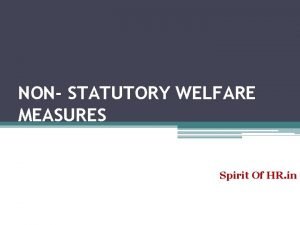



![Re sigsworth [1935] 1 ch 98 Re sigsworth [1935] 1 ch 98](https://slidetodoc.com/wp-content/uploads/2020/11/2622762_9c0b40fdfa873b88113dc8731de4a266-300x225.jpg)
